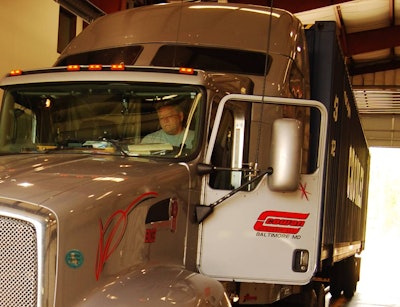
As your business gets established and you can predict decent earnings on a regular basis, establish long-term personal savings plans and work a weekly or monthly savings contribution, however modest, into your budget. Retirement saving is critical for you as an owner-operator because you’re self-employed. Saving for children’s education, vacations or other personal goals also is important.
PLANNING FOR RETIREMENT
If you maintain your current spending and savings habits, will you have enough money to retire comfortably? A U.S. Department of Labor study found that Social Security will replace only about 40 percent of pre-retirement income for the average American. Yet experts say that after you retire, you’ll need about 70 percent of the income you earned before retirement to maintain your lifestyle.
A trucker who earns $60,000 annually will need about $42,000 a year after he retires. When that figure is multiplied by 20 years – the average post-retirement longevity – that trucker will need about $840,000 to live comfortably. That entire amount doesn’t have to be saved in advance. Some of it would be income from investments during retirement.
Although it’s never too late to start saving for retirement, the sooner you begin, the better, even if it’s only $25 a week. The biggest reason to start saving early is that invested money compounds. The earlier you invest, the more time your money has to grow.

If a 25-year-old puts $400 into a retirement fund every month until he reaches age 65, and his money grows 10 percent a year, he will retire with almost $2.5 million. If a 35-year-old invests the same amount each month and earns 10 percent, he will have a little more than $900,000 at age 65. That’s a difference of $1.6 million.
The most common excuse cited by non-saving owner-operators is that setting money aside is too difficult. Yet average owner-operators earn more than $50,000 a year, according to Overdrive research. Their real difficulty in long-term saving clearly isn’t income, but rather difficulty controlling spending.
A surprising number of these non-savers – 17 percent – say they’re investing their money in their owner-operator business, with plans to sell it and retire on the proceeds. Financial advisers always frown on such an eggs-in-one-basket approach.
If your trucking business faces financial difficulties, then your retirement savings can be decreased substantially – or even wiped out. Think of your trucking business as only part of your portfolio – and a high-risk part at that. Expansion beyond one truck is becoming less common, by some measures. According to Overdrive’s annual population study, fleet size for an owner-operator declined from 1.66 trucks in 2001 to just 1.4 trucks in 2013.
QUALIFIED RETIREMENT PLANS
When you make investments that are not part of a retirement program, you’ll pay taxes on earnings, such as interest from a savings account or profit from a stock sale. With qualified retirement accounts, you don’t pay a penny in taxes on the earnings until you retire and begin withdrawing money. Not only are taxes delayed for many years, but by then you should be in a lower tax bracket, so you’ll pay less in taxes.
In addition, most retirement plans allow you to deduct contributions from your reported income. That means if you make $40,000 and contribute $2,000 to a qualified plan, you report only $38,000 on your income tax return.
The most popular qualified plans for owner-operators are Individual Retirement Accounts. A banker, stockbroker or mutual fund company can get you the paperwork and help you choose one or more investments to make up the IRA.
Contributions can be put into certificates of deposit, money-market accounts, savings accounts, mutual funds, stocks, bonds and U.S. Treasury securities. The higher the risk, the higher the potential rate of return.
PLANS FOR THE SELF-EMPLOYED
Retirement plans with varying regulations are available for self-employed people. Before committing money to any investment, check with your accountant or a financial adviser.
TRADITIONAL IRA. You are allowed to contribute $5,500 a year, tax-deferred, to an IRA, through tax year 2015 with a catch-up contribution limit of $1,000 for individuals age 50 and older. As long as you’re not covered by an employer-sponsored retirement plan, all contributions to an IRA reduce your taxable income and are tax-deferred. If you or your spouse contributes to an employer-sponsored plan such as a 401(k), only a portion of your contribution to an IRA is deductible. When you put your money in an IRA, you cannot withdraw it before age 59.5 – except under special circumstances – without incurring a hefty penalty.
ROTH IRA. The differences between a traditional IRA and a Roth IRA are the terms of contributions and payout. With a Roth IRA, contributions are not deducted from income, but they do accumulate tax-deferred. When you withdraw the money, it’s tax-free.
SIMPLE IRA. The SIMPLE (Savings Incentive Match Plan for Employees) IRA was designed for companies with fewer than 100 employees, and as the owner of a small trucking business, you and your employees qualify. Under a SIMPLE IRA arrangement, an employee of your business can contribute to and be matched by you up to $12,500 in 2015, with a $3,000 catch-up contribution limit for those 50 and older. Similar penalties are applied upon early withdrawal.
SEP IRA. A Simplified Employee Pension plan allows an employer to contribute up to 25 percent of net income (up to $53,000 total) to an IRA set up for himself and/or his or her employees. After money is put into the plan, it must stay there until you’re 59.5. Early withdrawals are subject to federal income taxes and a possible 10 percent penalty.
INDIVIDUAL 401(k). For years, 401(k) retirement plans, another form of tax-deferred savings, were limited to employees, often with an employer match as a savings incentive. Since 2001, however, individuals have been free to set up solo 401(k)s, which have an annual contribution limit of up to 25 percent of income or $18,000, whichever is lower, in 2015, as long as you are classified as an employee of your own business and are paying yourself a salary. If you’re self-employed, the rules are more complicated. See IRS publication 560’s rate table and worksheets for determining your contribution limits.
ROTH 401(k). A newer retirement plan option is a combination of the Roth IRA and the solo 401(k) called the Roth 401(k): Money you put into it is taxed in the year you earned it, but never again. Many financial advisers believe a Roth 401(k) is by far the best deal for an owner-operator. Assuming that taxes will go up in the long term is the safest of bets, so paying now locks in the lower rate. Also, the more taxes you can pay now while you’re younger, the better. Midlife expenses such as young children, a monthly mortgage and that growing business all make great write-offs to lower your tax bill.
OTHER PERSONAL SAVINGS
The basic principles of retirement savings also apply to any other savings you do. The major differences involve taxes.
Your accountant or financial adviser can explain the options for savings for children’s education. Some of them – like qualified retirement plans – are tax-exempt.
There are no tax advantages for shorter-term personal savings, such as for a vacation, a holiday fund or your next vehicle. Nevertheless, it’s wise to anticipate such spending and save for it. You’ll spend less for those things by paying cash (and gaining a small accumulation of short-term interest or dividends) than you will by putting them on a credit card or by taking a consumer loan and paying double-digit interest.
LEARN TO TAKE STOCK OF THE MARKET. Think of your stock investments as a loaded trailer: The more evenly distributed the weight, the more stable the ride. When you spread your money among multiple investments, at least one of those investments is almost sure to grow. When it does, experts say, resist the temptation to move all your money into that growth investment. Instead, redistribute the gains so that your portfolio never becomes top-heavy in any one area.
Certain mutual funds, such as Ameriprise’s Portfolio Builder series and Fidelity Investments’ Freedom series of funds, constantly do this sort of reallocation. But most individual investors don’t, which is why the average investor earns less than a 3 percent return every year compared to the stock market’s historical average of 12 percent.
Think of stocks the way you think of truck tires. If a dealer had a reverse tire sale, doubling its prices, would you be more or less inclined to buy those tires now rather than later? Yet when stock prices double, that expensive stock is the one that novices want to buy. And when the market has a sudden drop, novices are more likely to dump those same stocks at rock-bottom prices, only to see them rebound in a few months.
HELP IS OUT THERE. Basic advice can be found online for free via public agencies such as the IRS, as well as many private groups. Owner-operators who already have accountants or business services providers should enlist them in their retirement planning. Those serious about saving also may want to hire a financial adviser to handle their retirement portfolios. Some advisers work on a flat yearly fee; others charge a commission based on investment transactions. Ask prospective advisers if they have passed the Series 7 exam administered by the National Association of Securities Dealers. Also ask to see their official bio – a detailed resume that includes information mandated by the U.S. Securities and Exchange Commission, including education and any skirmishes with the SEC.
HOW MUCH IS ENOUGH? To get a preliminary idea of your “magic number,” begin by calculating your current annual nonbusiness spending, such as housing, food, personal vehicles and entertainment. Keep in mind that in retirement, you ideally will spend less on some things (such as mortgages) and more on others (such as travel). Then assume a 4 percent inflation rate every year.
Now do the really scary thing and calculate your life expectancy. Various online calculators will ask for your age, sex, height, weight, blood pressure and cholesterol level, as well as your family history and other variables. Don’t be surprised if you’re looking at 20-plus years of retirement.
Another way to think of your retirement savings goal is to imagine living off the interest it accumulates. Calculating the annual interest from your target savings goal, at various rates, shows how much annual income would result.
TAKE SOCIAL SECURITY EARLY OR LATE?
You have a choice whether to begin receiving Social Security benefits early (age 62) or at full retirement age (at 66 if you were born between 1943 and 1959, at 67 if 1960 and later). Say you’re 62 and are like the typical owner-operator with a working income of about $51,000 averaged over enough years to qualify; you would be eligible for $1,050 a month now or $1,393 a month at age 66.
If you start now, by the time you turn 66, you’ll have collected $50,400 in benefits. If you start at 66, you’ll need to live through age 78 and a half to make up for those missed benefits; beyond that, the higher payments would be to your advantage.
Social Security payments are taxable at levels that depend on your income, which can skew these calculations a bit. If you want to do this precisely for your situation, take it into consideration and get with your accountant. Or visit ssa.gov/planners for some good calculators.









